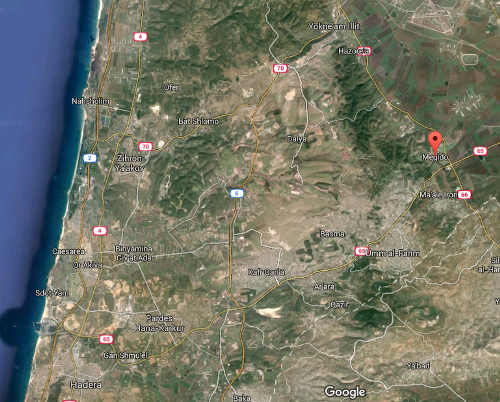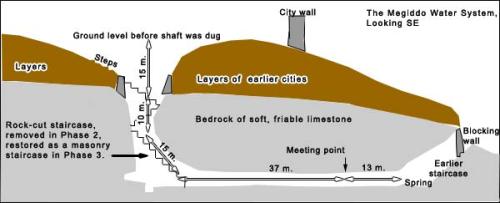#sponsored travel
Northeast of Caesarea (our previous stop) is Megiddo, Israel, the site of the biblical Armageddon. The word Armageddon only appears once in the Bible:
"Armageddon" is actually a combination of two Hebrew words - "Har" which is "mountain" or "range of hills" in English and "mgiddown" which is "Megiddo" in English. In the Book of Revelation, we can read about John's vision of future events. His vision occurred when he was imprisoned on the island of Patmos, in the Aegean Sea, for proclaiming Jesus as the Messiah. He was a beloved apostle of Jesus and was over 90 years old when the vision occurred.
Revelation 16 tells us about the coming "battle on the great day of God Almighty" and details The Seven Bowls of God's Wrath that will be poured out on the earth. The Book of Revelation is both fascinating and terrifying. And there I was, standing on Megiddo, overlooking the fertile Jezreel Valley.
The valley is huge, stretching for miles in many directions, and I tried to take photos of it in a series, sort of like a panoramic picture, to try to capture the immensity of it. This valley is the place of many battles throughout history. Recent excavations of the Megiddo tell (hill) have revealed well over 20 layers of civilizations that date back 8000 years.
Megiddo is first mentioned in Joshua, the sixth book of the Bible. Joshua lived during the Canaanite period, and was second in command to Moses. Joshua was a great military leader who led the conquest of the Promised Land. In the Book of Joshua, there is a list of kings defeated by Joshua, including the one from Megiddo.Joshua 12: 20 the king of Shimron-meron, one; the king of Achshaph, one; 21the king of Taanach, one; the king of Megiddo, one; 22the king of Kedesh, one; the king of Jokneam in Carmel, one;
More photos of the valley view from the top:
You can see why Megiddo is a great place to build a city! You can see for miles in many directions and would know when an enemy was advancing on the city.
Below, you can see there is a road. This road, the Via Maris, translated "the way of the sea," was the most important ancient trade route from Syria in the north (ancient Mesopotamia) to Egypt in the south. Having control of that trade route in ancient times was invaluable. The same general route still exists today.
Ancient stone steps leading up to the top of the Megiddo tell (hill).
King Solomon of Israel was instrumental in building up the city as one of his main fortresses, and had these mighty gates built at Megiddo.
1 Kings 9: 15 And this is the reason for the labor force which King Solomon raised: to build the house of the Lord, his own house, the Millo, the wall of Jerusalem, Hazor, Megiddo, and Gezer.
Excavations have revealed remnants of temples, palaces, buildings, storehouses, stables, and much more. I even saw two horse troughs chiseled in stone.
In the picture below is a huge circular altar that was used for animal sacrifice during the Canaanite period. It measures almost 26 feet in diameter and 5 feet in height. There is a wall around it and to the lower left of the altar is a set of steps leading up to the top of it. Notice too, how deep the ground was dug to reach it, compared to the dirt of the hill behind it.
Below is a grain silo that was discovered at Megiddo. It holds 450 cubic meters, or 118,877 gallons, of grain. Standing at the edge, all I could think was, "I hope I don't fall in!"
Along the inside of the wall of the grain silo, is a ramp of sorts, like steps, that could have been used to go down to get grain as supplies got low (and to get out while it was being constructed).
The most important element for any city, is, of course, water. The area of Megiddo has several springs of fresh water. The best way to destroy a city is to ruin its water supply, so an elaborate water system was built. It is believed to have been built by Ahab in the 9th century BC so that no one would have to leave the safety of the city walls to get water. It was dug out from both ends, meeting in the middle.
We walked down the 30 meter (98 feet) deep shaft that was chiseled down from inside the city and walked along the 70 meter (229 feet) long tunnel that led out to the spring in ancient times. The tunnel entrance was covered so enemies couldn't find the water system. The water system was dry when I visited, except for one small area near the spring end of the tunnel.
I found this drawing online at http://www.netours.com/content/view/139/26/1/3/ that demonstrates the water system:
Megiddo is rich in history and there are hundreds of websites and books in which you can read more about its past and its prophesied future. It was humbling to be standing on Megiddo, hearing about all the battles that have been fought there, even up to 1918 between British forces and the Ottoman empire. It's even more humbling to read the Book of Revelation about the coming final battle between Good and Evil.
Israel is an amazing place to visit! Historians will love the stories of the past, artists will love the beauty of the country, and Christians will love walking in the steps of the biblical people they've met through the stories of the Bible.Learn more about visiting Israel at the website of the Israel Ministry of Tourism.
Read more about my travels HERE.
Follow me on Facebook and Twitter.
Share this story with the buttons below!



No comments:
Post a Comment
Note: Only a member of this blog may post a comment.